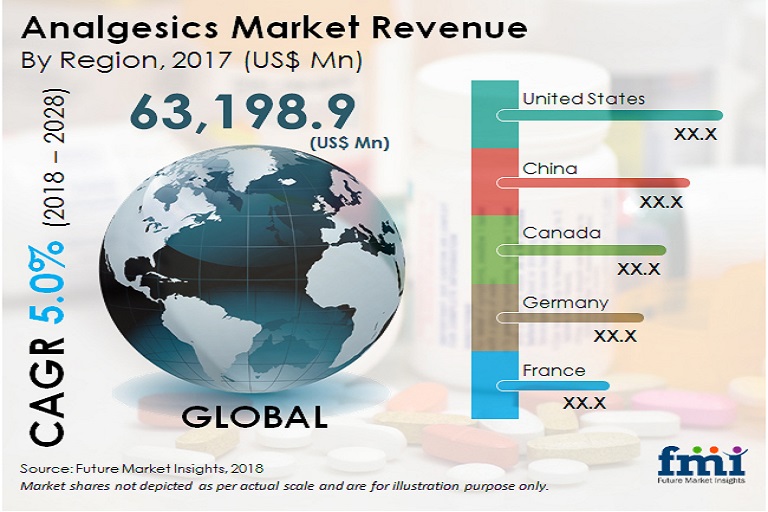By drug class, opioids are widely used analgesic drugs for treating moderate to severe pain such as pain caused by surgery, cancer, trauma, injury, and other diseases. Owing to their high efficiency and widespread availability in the developed markets of North America and Western Europe, opioids are a high revenue generating segment in the global analgesics market. In a new research publication, leading market research firm Future Market Insights presents forecasts on revenue generated from the sales of branded and generic analgesic drugs including opioids, non-steroidal anti-inflammatory drugs (NSAIDs), acetaminophen, and local anaesthetics.
According to Future Market Insights’ projections, the global prescription analgesics market is anticipated to reach a whopping US$ 79 Bn by 2028 end, up from an estimated US$ 47.5 Bn in 2018. This is indicative of a CAGR of 5.3% during the 10 year period from 2018 to 2028. This growth is mainly contributed by the regional markets in North America and Western Europe that are projected to collectively hold a revenue share of just under 71% in 2018.
Read On to the More Advanced Regarding Prescription Analgesics Marke: https://www.futuremarketinsights.com/reports/sample/rep-gb-1306
Commercialization of Abuse Deterrent Opioid Drugs to Provide Lucrative Growth Opportunities to Pharmaceutical Majors in the Analgesics Market
Following the U.S opioid crisis, several countries across the globe are introducing regulations pertaining to the prescription of opioids. To curb the growing abuse of painkilling drugs, pharma companies are introducing different types of abuse deterrent drugs in the global market. Opioids are widely used for pain management in North America and Europe and are being increasingly used for non-medical purposes as well. Government organizations in these economies are encouraging doctors to prescribe non-opioid analgesics. This is slated to create significant growth opportunities for companies to introduce novel non-opioid drugs in these markets. The situation in the countries of Asia and Africa is different – the limited availability of both opioid and non-opioid drug delivery systems for pain management provides immense opportunities to manufacturers of analgesics for regional market penetration.
Opioid intolerance is a new phenomenon that has hit the pharmaceuticals industry in North America and Europe. Opioids are ineffective in treating certain cases of severe pain, necessitating patients to take higher doses to alleviate the pain. This eventually makes them opioid intolerant or addicted to these drugs. Commercializing opioid tolerant drugs is the most viable solution that will help reduce the side effects associated with increasing consumption of opioids. Manufacturers in the global analgesics market are expected to benefit from the numerous opportunities presented by the commercialization of opioid tolerant drugs.
Development of Non-opioid Extended Release Drugs and Commercial Expansion via Novel Product Approvals to Fuel Revenue Growth
Key players in the global analgesics market are focused on R&D initiatives to develop non-opioid drugs using innovative drug delivery approaches to facilitate extended release of the medication, which can provide pain relief for a longer time duration. Pharmaceutical companies are also launching cost-efficient opioid drugs in Asian countries and this is expected to boost revenue growth in the global market for analgesics. Commercial expansion of products across potential growth markets in Asia and Africa is a feasible strategy being adopted by manufacturers of analgesics to expand their global market footprint.
Request to Browse Report Customization@ https://www.futuremarketinsights.com/customization-available/rep-gb-1306
Reimbursement for Palliative Care and Opioid Consumption Trending the Global Market
Opioids are largely used in palliative care for treating terminally ill patients. There is a growing focus on palliative care services across third world countries. This – coupled with readily available reimbursement options – is expected to boost the consumption of opioids in the coming decade. Several government initiatives to promote palliative care among patients suffering from cancer pain in low and middle income countries are promoting the adoption of opioids as an effective pain management solution.
Another trend being observed in the global market is the use of Opioids Maintenance Treatment (OMT) to treat Opioids Dependence (OD). The main objective of OMT is to reduce patients’ addiction to consume illicit drugs that are used to reduce opioid dependency. While there are certain controversies associated with the commercialization of OMT (it is claimed that OMT is another form of addiction), these drugs are highly regulated and the concerned governments are implementing stringent regulations to prevent abuse of these drugs.










































